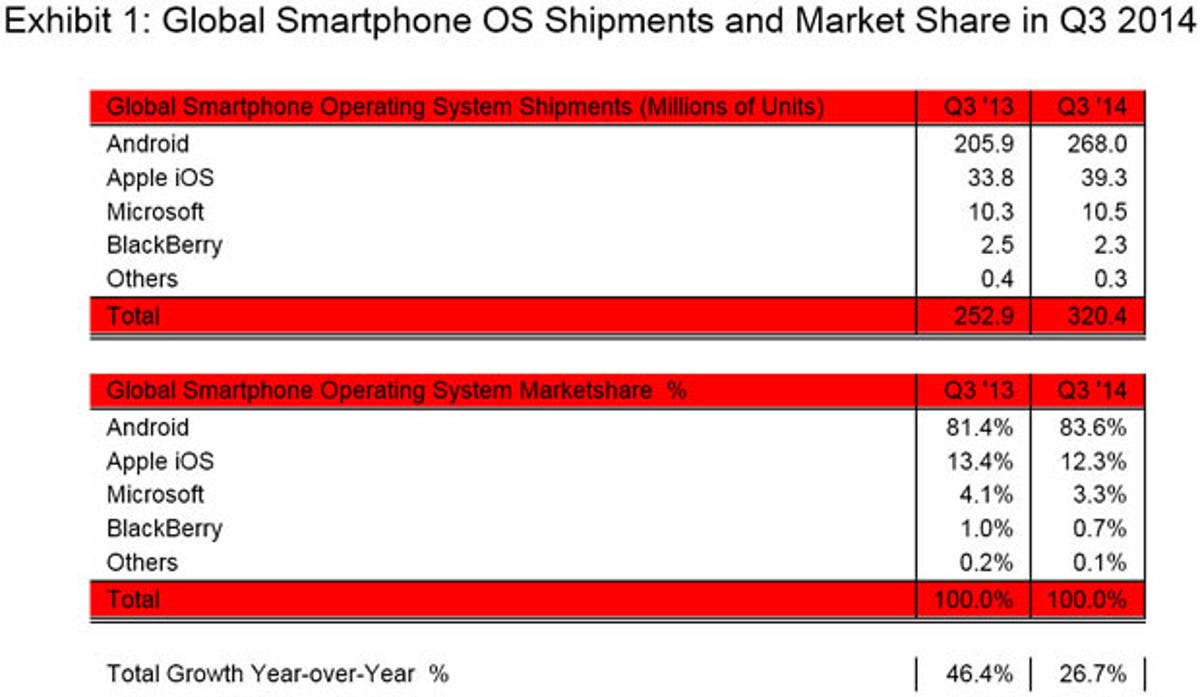
CNET
Android continued to dominate the smartphone market last quarter, far outpacing Apple’s iOS, according to research released Friday by Strategy Analytics.
For the third quarter, global shipments of Android-based smartphones reached 268 million, up from 206 million for the same quarter a year ago. Those numbers helped the OS win a market share of 84 percent, up from 81.4 percent in the year-ago quarter. Strategy Analytics cited the power of Android overall but did point to challenges for individual Android device makers.
“Android’s leadership of the global smartphone market looks unbeatable at the moment,” Neil Mawston, executive director at Strategy Analytics, said in a statement. “Its low-cost services and user-friendly software remain attractive to hardware makers, operators and consumers worldwide. However, challenges are emerging for Google. The Android platform is getting overcrowded with hundreds of hardware brands, Android smartphone prices are falling worldwide, and few Android device vendors make profits.”
Related stories
- Editors’ take: Android 5.0 Lollipop
- Google on Android Lollipop security: Set it and forget it
- Android and Chrome may come together, but don’t expect changes yet, Google says
- Editors’ take: iOS 8.1
- Apple’s iOS 8.1 arrives with Apple Pay, iCloud photo library
Still, other mobile operating systems trailed Android’s grip of the market. Apple ‘s iOS finished the third quarter with smartphone shipments of 39.3 million, compared with 33.8 million in the same quarter of 2013. But over the same time Apple’s smartphone market share dropped to 12.3 percent from 13.4 percent. Strategy Analytics director Woody Oh blamed the dip on the limited presence of iOS devices at the lower end of the smartphone market.
During the third quarter, Apple introduced the new iPhone 6 and iPhone 6 Plus . The new models launched in the US, UK, Australia, Canada, France, Germany, Hong Kong, Japan, Puerto Rico and Singapore on September 19. The phones traveled to more than 20 additional regions on September 26.
By year’s end, Apple plans to sell the iPhone 6 in more than 115 countries. But the new iPhones are high-end devices, an area that continues to be Apple’s sole playing field. This year, the company did not introduce an equivalent of last year’s lower-cost iPhone 5C. Android, in contrast, offers a wider playing field with high-end, midrange, and low-end phones and so is able to grab more sales worldwide, especially in developing markets.


Strategy Analytics
Beyond the top two smartphone players, Microsoft’s Windows Phone took third place with global shipments of 10.5 million, up slightly from 10.3 milllion in the year-ago quarter. But its market share dippped to 3.3 percent from 4.1 percent. Strategy Analytics noted that Windows Phone “continued to struggle in China and Japan.” China is the the world’s largest smartphone market, and so represents a substantial source of sales for mobile phone makers.
In fourth place, BlackBerry saw its shipments dip to 2.3 million from 2.5 million, while its market share inched down to 0.7 percent from 1 percent. BlackBerry is trying to stay alive in the smartphone market by introducing such phones as the BlackBerry Passport and the upcoming BlackBerry Classic. But the company faces an uphill battle just to hold what little market share it has left.
Overall, global smartphone shipments rose by 27 percent last quarter, thanks in large part to developing markets. Third-quarter shipments hit 320 million units, compared with 253 million in the prior year’s quarter.



